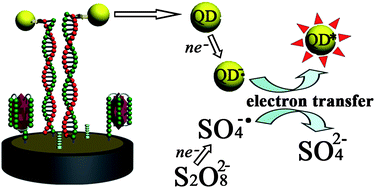DNA aptasensor for the detection ofATP based on quantum dots electrochemiluminescence
Abstract
A novel and facile strategy for the fabrication of

* Corresponding authors
a
Key Lab of Analytical Chemistry for Life Science (MOE), School of Chemistry and Chemical Engineering, Nanjing University, Nanjing, P.R. China
E-mail:
jjzhu@nju.edu.cn
Fax: +86-25-8359-4976
Tel: +86-25-8359-497
b Center for Materials Analysis & Testing, Jiangxi University of Science and Technology, Ganzhou, P.R. China
A novel and facile strategy for the fabrication of

 Please wait while we load your content...
Something went wrong. Try again?
Please wait while we load your content...
Something went wrong. Try again?
H. Huang, Y. Tan, J. Shi, G. Liang and J. Zhu, Nanoscale, 2010, 2, 606 DOI: 10.1039/B9NR00393B
To request permission to reproduce material from this article, please go to the Copyright Clearance Center request page.
If you are an author contributing to an RSC publication, you do not need to request permission provided correct acknowledgement is given.
If you are the author of this article, you do not need to request permission to reproduce figures and diagrams provided correct acknowledgement is given. If you want to reproduce the whole article in a third-party publication (excluding your thesis/dissertation for which permission is not required) please go to the Copyright Clearance Center request page.
Read more about how to correctly acknowledge RSC content.
 Fetching data from CrossRef.
Fetching data from CrossRef.
This may take some time to load.
Loading related content
